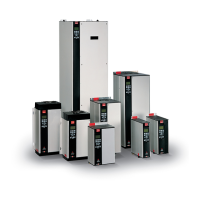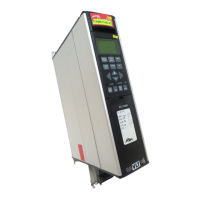4-2
VLT is a registered Danfoss trademark
Overvoltage Trips
This trip occurs when the DC bus voltage reaches its DC bus
alarm voltage high (see ratings tables in introductory section).
Prior to the trip, the drive will display a high voltage warning.
Most times an over voltage condition is due to fast deceleration
ramps with respect to the inertia of the load. During deceleration
of the load, inertia of the system acts to sustain the running
speed. Once the motor frequency drops below the running
speed, the load begins overhauling the motor. At this point the
motor becomes a generator and starts returning energy to
the drive. This is called regenerative energy. Regeneration
occurs when the speed of the load is greater than the
commanded speed. This return voltage is rectified by the diodes
in the IGBT modules and raises the DC bus. If the amount of
returned voltage is too high, the drive will trip.
There are a few ways to overcome this situation. One method
is to reduce the deceleration rate so it takes longer for the
drive to decelerate. A general rule of thumb is that the drive
can only decelerate the load slightly faster than it would take
for the load to naturally coast to a stop. A second method is to
allow the overvoltage control circuit to take care of the
deceleration ramp. When enabled in VLT 5000 parameter 400,
the overvoltage control circuit regulates deceleration at a rate
that maintains the DC bus voltage at an acceptable level. In
VLT 4000/6000/8000 drives, auto ramping enables a similar
function in parameter 208. One caution with overvoltage control
is that it will not make corrections to unrealistic ramp rates.
For example, if the deceleration ramp needs to be 100 seconds
due to the inertia, and the ramp rate is set at 3 seconds,
overvoltage control will initially engage and then disengage and
allow the drive to trip. This is purposely done so the units
operation is not misinterpreted. A third method in controlling
regenerated energy is with a dynamic brake. With this system
the optional brake electronics are built into the VLT 5000 drive
with an external resistor bank mounted outside of the drive.
The drive monitors the level of the DC bus. Should the level
become too high, the drive switches the resistor across the
DC bus and dissipates the unwanted energy into the resistor
bank. This will actually increase the rate of deceleration.
Less often is the case that the overvoltage condition is caused
by the load while it is running at speed. In this case the dynamic
brake option can be used or the overvoltage control circuit. It
works with the load in this way. As stated earlier, regeneration
occurs when the speed of the load is greater than the
commanded speed. Should the load become regenerative
while the drive is running at a steady state speed, the
overvoltage circuit will increase the frequency to match the
speed of the load. The same restriction on the amount of
influence applies. The drive will add about 10% to the base
speed before a trip occurs. Otherwise, the speed could
continue to rise to potentially unsafe levels.
In applications with very high inertia, such as a centrifuge, it is
recommended to use a VLT 5000 Flux drive.
Mains Phase Loss Trips
The drive actually monitors phase loss by monitoring the amount
of ripple voltage on the DC bus. Ripple voltage on the DC bus
is a product of a phase loss. The main concern is that ripple
voltage causes overheating in the DC bus capacitors and the
DC coil. Left unchecked, the lifetime of the capacitors and DC
coil would be drastically reduced.
When the input voltage becomes unbalanced or a phase
disappears completely, the ripple voltage increases causing the
drive to trip and issue an Alarm 4. In addition to missing phase
voltage, increased bus ripple can be caused by a line disturbance
or imbalance. Line disturbances may be caused by line notching,
defective transformers or other loads that may be effecting the
form factor of the AC waveform. Line imbalances which exceed
3% cause sufficient DC bus ripple to initiate a trip.
Output disturbances can have the same effect of increased
ripple voltage on the DC bus. A missing or lower than normal
output voltage on one phase can cause increased ripple on
the DC bus. Should a mains imbalance trip occur, it is necessary
to check both the input and output voltage of the drive.
Severe phase imbalance or phase loss can easily be detected
with a volt meter. Line disturbances most likely need to be
viewed on an oscilloscope. Conduct tests for input phase
imbalance, input waveform, and output phase imbalance as
described in Section 5.
